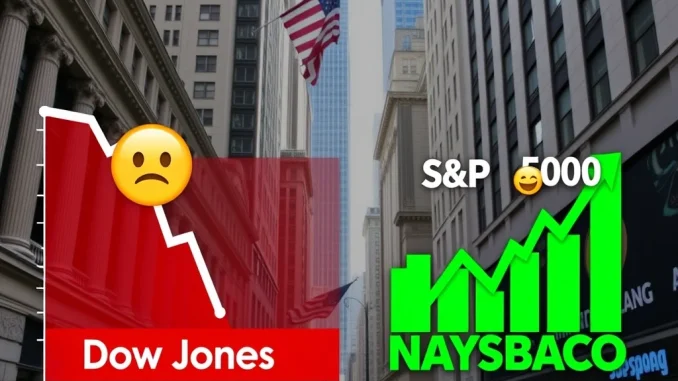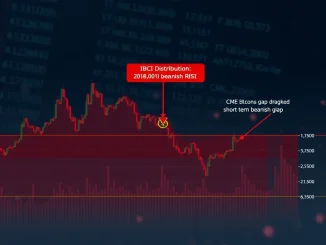
Wall Street presented a fascinatingly mixed picture as trading concluded today, leaving investors and analysts alike parsing through the nuanced data. While the tech-heavy NASDAQ managed to stay afloat and the S&P 500 eked out a gain, the Dow Jones Industrial Average took a significant tumble. What does this mixed market signals mean for your investment strategy? Let’s dive into the details.
Decoding the Day’s Stock Market Close: A Tale of Three Indices
The closing bell painted a canvas of contrasts across the major U.S. indices. Here’s a snapshot of how each index performed:
- S&P 500: Climbed by a modest +0.13%, indicating a slight overall positive sentiment in the broader market.
- NASDAQ: Slipped slightly by -0.13%. This near-flat performance suggests resilience in the tech sector but also hints at underlying pressures.
- Dow Jones Industrial Average: Experienced a substantial drop of -1.33%. This decline raises eyebrows and warrants a closer look at the factors influencing blue-chip stocks.
Why this divergence? It’s crucial to understand that each index represents different segments of the U.S. economy. The Dow Jones, comprised of 30 large, established companies, often reflects the performance of traditional industries. The S&P 500, encompassing 500 of the largest U.S. publicly traded companies, provides a broader view of the market. The NASDAQ, heavily weighted in technology stocks, is often seen as a barometer for growth and innovation sectors.
Why Did the Dow Jones Plunge While Others Wavered?
The significant drop in the Dow Jones warrants further examination. Several factors could be at play:
- Sector-Specific Weakness: Certain sectors heavily represented in the Dow, such as industrials or financials, might have faced headwinds today. News or earnings reports specific to these sectors could have triggered the downturn.
- Interest Rate Sensitivity: Blue-chip stocks in the Dow can be more sensitive to interest rate changes. Any hints or expectations around interest rate hikes can disproportionately affect these companies.
- Global Economic Concerns: The Dow, with its multinational corporations, is often more exposed to global economic uncertainties. International news or economic data releases could have spooked investors in these established companies.
In contrast, the S&P 500’s marginal gain and NASDAQ’s near-flat performance suggest that other market segments, possibly growth stocks or specific sectors within the S&P 500, might have shown strength or resilience, offsetting the Dow’s weakness.
Investor Caution in the Face of Uncertainty
The mixed market close is a clear signal of investor caution. The lack of uniform direction across the major indices reflects uncertainty and a hesitancy to make strong directional bets. This cautious approach could be driven by a variety of macroeconomic factors:
- Inflationary Pressures: Ongoing concerns about inflation and the Federal Reserve’s response continue to weigh on investor sentiment.
- Geopolitical Risks: Global political events and tensions always add an element of unpredictability to the markets.
- Earnings Season Volatility: With earnings season underway, individual stock movements can be amplified, contributing to overall market choppiness.
In such an environment of mixed signals, investors often become more selective and risk-averse. They may favor companies with strong balance sheets, consistent earnings, or sectors perceived as defensive in nature.
Navigating a Mixed Market: Actionable Insights
So, what should investors do when faced with such a mixed stock market close? Here are a few actionable insights:
- Diversification is Key: A diversified portfolio across different asset classes and sectors becomes even more crucial in uncertain times. Don’t put all your eggs in one basket.
- Focus on Fundamentals: Pay close attention to the underlying fundamentals of companies you invest in. Strong companies with solid earnings potential are more likely to weather market volatility.
- Stay Informed, but Don’t Panic: Keep abreast of market news and economic data, but avoid making impulsive decisions based on short-term fluctuations. Long-term investment strategies should be based on thorough research and conviction.
- Consider Sector Rotation: In a mixed market, different sectors may perform differently. Consider adjusting your portfolio to favor sectors that are showing relative strength or are poised to benefit from prevailing economic conditions.
Conclusion: Decoding the Signals for Strategic Investing
Today’s stock market close, characterized by mixed signals and a notable Dow Jones decline, underscores the complexities and uncertainties currently influencing the financial landscape. Investor caution is palpable, and navigating this environment requires a strategic and informed approach. By understanding the nuances of each index, staying attuned to market drivers, and focusing on long-term fundamentals, investors can position themselves to weather the volatility and capitalize on opportunities that may arise even amidst market turbulence. The key takeaway? Don’t be swayed by the daily noise; instead, decode the signals and make informed decisions aligned with your investment goals.



